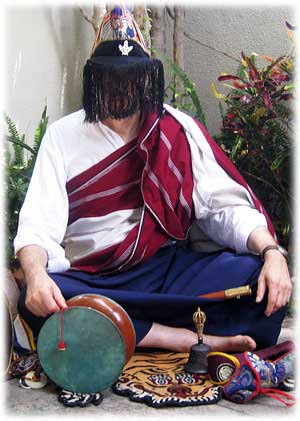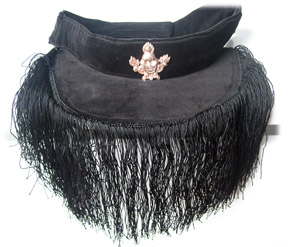 Chod Hat: Domra
Chod Hat: Domra
Demon-Seer Chod Hat
The domra is absolutely unique to the practice of Choda and once you understand its tantric significance, you may decide it is also absolutely essential! Both head and facial ornament, it was brought to Tibet by the great master of Shije, Padampa Sangye. The origin of its name (Tibetan dom = bear) stem from the fact that traditionally these tassles are made from the long-haired Tibetan black bear.
Construction
Its construction is straight-forward: There is a short visor (not unlike one a poker player or sunbather might wear) jutting out 4 to 6 inches from the forehead. This is made of black felt with a black or red underside, from hang vertical black strings. About 6 inches in length, these are traditionally made of bear, or yak hair, though nowadays cotton, silk or polycotton strings have taken their place.
This allows the practitioner to see clearly through this screen, but his/her eyes are obstructed to the outside viewer.
The domra Chod hat is in standard use by certain lineages of Chod practitioners, and seldom if ever used by others. It remains popular among Nyingtig practitioners, as well as followers of the lineage of Padampa Sangye\’”such as the renowned Lama Wangdu Rinpoche. And it is more likely to be seen on solo practitioners and wandering yogis than in group practice that occurs in the larger monastic assemblies.
Symbology of the Chod Hat
A definitive Tibetan compendium on various dharma objects \’The Implements and Dharma Materials of the Insurpassible Vajrayana\’ (Nyagur Nyingma College, 2003). briefly describes the background meaning and symbolism of a wide variety of dharma clothes, musical instruments and ritual objects. It has this to say about the symbolism of the Chod Yogins Hat:
“The absence of the lateral folds is a sign that there is no attachment to samsara. The upper part being unblemished by any ornament means one is free from the husk of self-grasping, and will see ones original face as the fundamental nature itself. The forehead ornamentation of hair arranged in strings is a symbol that one gathers the yoginis and is never separate from them. Thus unruly hordes of the eight classes of demons are not able to trample us.”
Tantric Function
The purpose of this unusual apparatus is unusual: to shield the timid and frightened spirits from the brilliance of the practitioners powerful gaze. The energy streaming from the eyes of an individual who has some Chod experience or realization can indeed be overwhelming and overpowering for lower spirits, even though they are themselves noxious and frightening harm-doers. It is thus out of compassion that one wears the tomra, to allow all lower guests to partake of the red feast.
This Chod hat can also be worn during any peaceful torma offering (such as a kartor), where one does not wish to appear threatening to local spirits. Additionally it is sometimes used during certain phases of sur (smoke offerings for the dead) where, once again, one wishes to shield the bardo beings from the yogins powerful gaze.
However the deeper energetic and shamanic purpose of Vajrayana Implements is not generally discussed in traditional texts. Such information stays within the line of oral transmission, or is left for the discovery of the practitioner during meditative states. Thus the domra is far more than an outer shield; It is also a magnifier of inner vision. Using the domra, one becomes attuned to the presence of the \’outer demons,\’ and as the ongoing Chod ritual and meditation deepen, to ones inner demons as well. Possibly this is due to the insulation from the outer world that one feels when using such a \’mask.\’ But clearly more is at work here. In fact the domra is a remarkable piece of sacred science that provides direct seeing into deeper realms and dimensions, the kind of vision that greatly helps the compassionate work of the Chopa.
Cho Hat: Shamo
The Dorje- Shamo (Vajra Hat) is particularly linked to the Chod tradition through the Third Karmapa. The most important early codifier of the Chod tradition, his collection of texts, the Rinpoche Tsogley Trengwa o r Precious Rosary, have been fully assimilated by all Nyingma Chod traditions. Thus his hat is also in widespread use by virtually all Nyingtig and other Nyingmapa chopas. It is made of brocade silk, with a two color pattern, somewhat similar to the common practice hat worn by Kagyu and Nyingma lamas in general. But it is distinguished by having no flaps, but instead a stiff lower collar in a lotus pattern. It is thus somewhat similar to the Rechungpa hat, with its fur collar, a hat that is also traditionally shown on the head of Tonyon Samdrup, MaChikâs son. Usually the upper and lower sections are dark blue with red trim, as illustrated here. For a less-wrathful approach, the reverse colors can be used. Dudjom practitioners of the Troma cycle wear a similar-shaped hat, the crow (karak) shamo, with its characteristic upper bird shape. This is also seen in various other wrathful rituals, such as Zor, for averting negative conditions.
KPICASA_GALLERY(Chod Hats)

